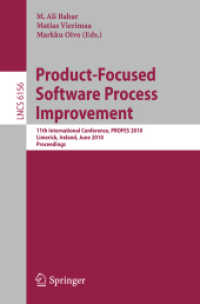- ホーム
- > 洋書
- > ドイツ書
- > Mathematics, Sciences & Technology
- > Technology
- > mechanical engineering & production engineering
Full Description
This updated edition adds new material on the acoustics of mufflers and ducts, including a new analysis on sound propagation in a duct having a cross sectional area that varies in the direction of the duct length. The textbook retains its class-tested fundamentals of engineering acoustics and examination of in-depth concepts within the domains that apply to reducing noise, measuring noise, and designing microphones and loudspeakers. The book particularly emphasizes the physical principles used in designing miniature microphones. These devices are used in billions of electronic products, most visibly, cell phones and hearing aids, and enable countless other applications. Distinct from earlier books on this topic that take the view of the electrical engineer analyzing mechanical systems using electric circuit analogies. This text uses Newtonian mechanics as a more appropriate paradigm for analyzing these mechanical systems and in so doing provides a more direct method of modeling. Written at a level appropriate for upper-division undergraduate and graduate courses, and enhanced with end-of-chapter problems and MatLab routines, the book is ideal as a core text for students interested in engineering acoustics in ME, EE, and physics programs, as well as a reference for engineers and technicians working in the huge global industry of miniature microphone design.
Contents
Analysis of acoustic signals.- One dimensional sound fields.- Sound Transmission Loss.- Analysis of mufflers and ducts.- Sound radiation in three dimensions.- Computer Aided Acoustics.- Modal Solutions for the Sound in Enclosures.- Geometrical Room Acoustics.- Effects of Viscosity.- Acoustic sensing.- Electronic transduction for acoustic sensors.- Estimation of capacitance.- Parameter identification of acoustic systems.- Appendix 1: The use of complex notation.- Appendix 2: Introduction to probability and random processes.- Appendix 3: The mean square response of a spring/mass/damper.- Appendix 4: Analysis of circuit noise.- Appendix 5: Some useful formulas.








